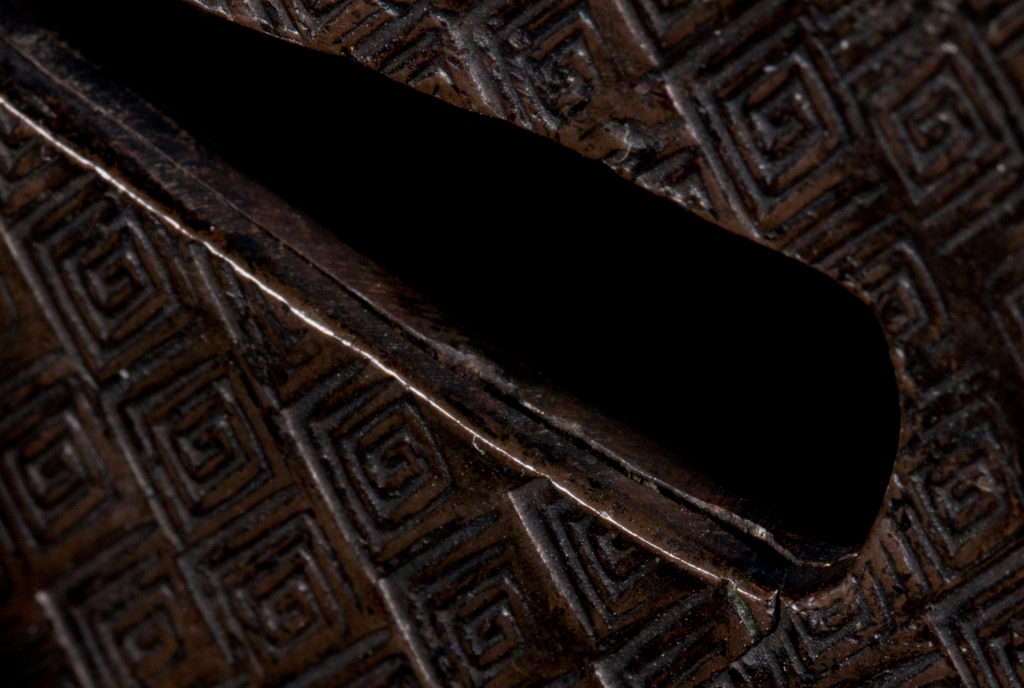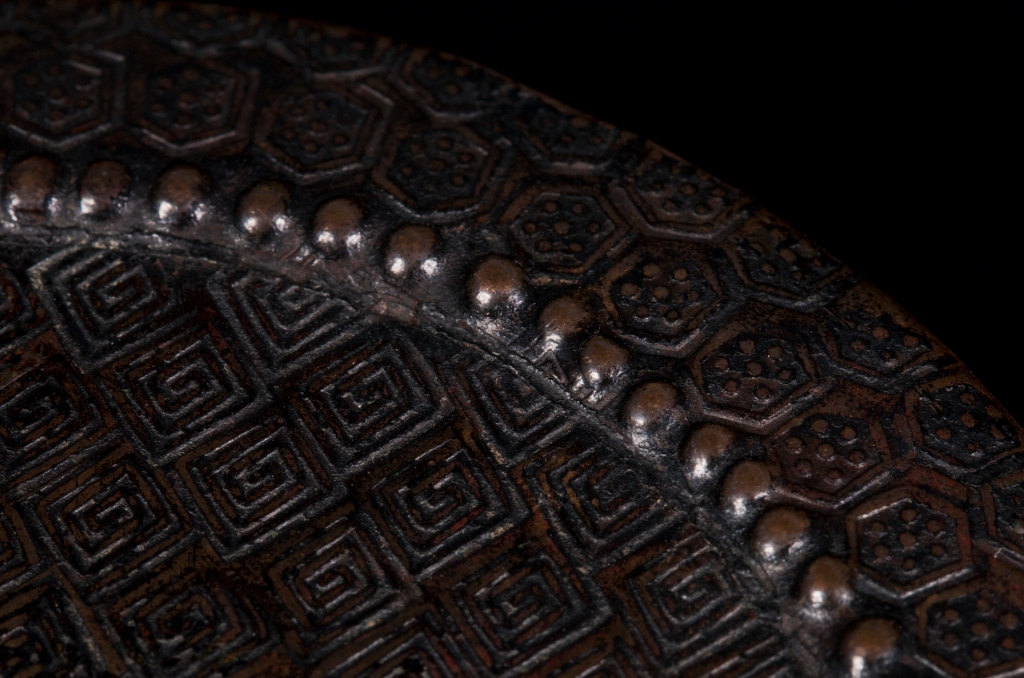Happy New Year! Here is is a rare and interesting sub-style of the so-called mirror maker tsuba. The motif is tortoise shell on the rim and lightning/thunder spirals on the web.


At first glance this looks like one of the tsuba made by taking two small bronze mirrors and mounting them back to back together after removing the central knobs and finishing off the rim with a fukurin. One of the nicer examples of that type is here:

In this case the plates are pinned together within the seppa dai. I owned a smaller one of these that did not use pins, and was actually made up of three plates. The outer pieces were repurposed hand mirrors on either side of a central plain copper plate. In any multiplate construction a fukurin is usually applied to finish off the rim, and in the case of that tsuba it was all that kept the plates together. When handling that type of guard of course it feels like a completely solid piece despite some small gaps between the plates.
The first tsuba above though clearly sounds hollow in both the rim and the plate and feels extremely light. A look inside the nakago ana shows that there are two pieces there, but the construction is more complicated than that.

This section shown above has a loose fit typical of multiplate tsuba, but the rest is quite tight, but with no sign of solder, etc., used.

Before going deeper into the weeds on possible construction, here are the other examples of this type of guard I’ve found in the literature.



Where noted, these are similarly sized yamagane tsuba that appear to share construction and decoration methods. It would be handy to examine them all, but since there’s only the one here I’ll continue with the details of that starting with the rim.


This isn’t the typical construction seen in either a fukurin or a dote mimi. The overlapping joint is at one edge of the rim, something like fitting a lid on a jar. At one point there is some damage to the rim that shows a bit more of what’s there:

Clearly the metal is very thin, and tapping on it makes a hollow sound about as you’d expect if there is nothing else in there.
The kikko mon tortoise shell pattern appears to be stamped in first, with the raised knobs being punched from the back afterward. The stamps are mostly well aligned, but there some that overlap.


On the side of the tsuba shown in the first photo at the top of the post it is hard to say if the rim is of one piece with the plate because there is a layer of lacquer all the way around.

But there is some working there that would suggest that it’s not one piece.

The central spiral designs also appear to be stamped showing variations in the strength of the hit, overlap and rotation. That the spirals are cut off at the edge of the plate is also likely consistent with it being a separate piece.

The above image is from the other side at around 7-8 o clock, and it shows another part of the story. This is adjacent to the part of the rim that is damaged and it appears that the impact may have broken loose the lacquer layer to reveal that the rim and plate are not made of one piece, at least on this side. An angle view shows the gap:

Going to the microscope, here’s a view of one end of the break:

At the bottom left there are some tool marks that may have been from working the joint between the plate and rim. The center looks typical of the lacquer all around the other side and the top right shows where it has gone missing.

Changing the angle of the microscope light to look into the gap it appears to be hollow. Checking the other, intact side of the plate with the microscope there are a few spots where the lacquer is starting to crack:

So while that is not conclusive I suspect that there is a joint there as well, and all of the rest above suggests that both sides are made the same way with two outer rings joined to two central plates. All of it is very thin. The guards from the literature show a similar looking line between the web and mimi pieces. The nested friction fit and crimping of one half of the rim over the other seems to be what is is holding the whole thing together.
On my example the web sounds hollow all the way up to the nakago ana, yet the photos of that at top show that it should be two solid ~2 mm thick plates. This would suggest that the edges of the thin plate are turned down at 90 degrees there, or maybe that there is a ring of that full thickness metal around the nakago ana to add strength. I’d like to have a look inside the hitsuana of the two guards above that have them to see what the edges look like.
Solid yamagane tsuba with stamped decorations and partial lacquer coating are fairly common, so why go to the trouble of making something this complicated? It is certainly much lighter than a solid plate, although when mounted on a sword I’m not sure how significant that difference would be. It definitely is a different look and we do tend to go out of our way to achieve that, but it seems like there may be more to this story.
If this guard looks familiar to those who have been around for a while it may be because it is the first example in the 1994 Masterpieces from the Randolph B. Caldwell Collection catalog. It is described there as being cast yamagane from the Fujiwara/early Kamakura period and as being accompanied by Tokubetsu Kicho certificate number 930 from 1969. The attribution given on that paper is not mentioned, but there is a recent tokubetsu hozon certificate describing this as Kagamishi.
Metallurgical cross sections are usually conclusive in determining cast vs. forged construction (or a combination with a piece being hammered after casting) which is not going to happen here, but it is hard to see where casting was a part of the process in the creation of the thin sheets used to build this tsuba. Aesthetically the result is similar to the kagamishi tradition, but of course there is no evidence that the single-piece cast tsuba of that type were the work of actual mirror makers. Still a useful term in discussion.
If I may ask: Do you intend to seel this piece? Sincerely, Sergei Varshavsky
LikeLike
Thanks, but no plan any time soon.
LikeLike